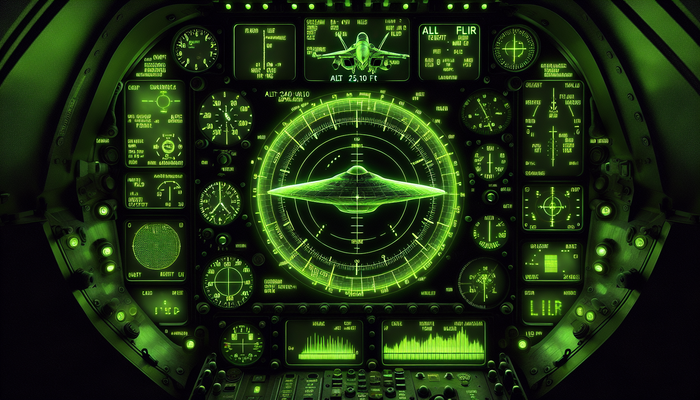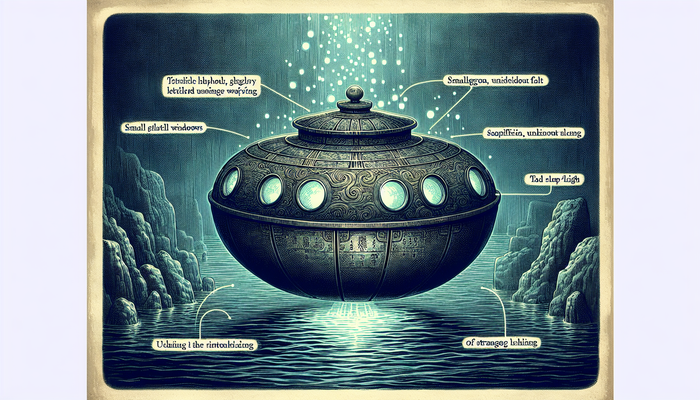Nazi UFO Legends: Separating Myth From Reality

By Elaine Westfield, Ufologist
The image appears in countless conspiracy websites and questionable documentaries: a sleek, silver disc bearing the unmistakable black swastika of the Third Reich, supposedly photographed during a test flight over German forests in 1944. These compelling visuals ask us to believe that before the atomic age had even dawned, Nazi scientists had already mastered anti-gravity technology and were mere months away from deploying a fleet of revolutionary aircraft that would have changed the course of World War II.
Had history been slightly different, proponents suggest, Hitler's "wonder weapons" might have prevailed against the Allies, establishing a thousand-year Reich built not just on tanks and bombers, but on flying saucers straight out of science fiction.
It's a narrative that's survived decades, growing from seeds planted in post-war speculation into a sprawling mythology that connects everything from wartime aerial phenomena to Antarctic expeditions, occult societies, alien contact, and shadowy government cover-ups. But how much of this fantastical tale is rooted in reality? Was the Third Reich genuinely on the brink of technological achievements that would make our modern stealth aircraft look primitive by comparison?
The truth is both more mundane and more fascinating than the legends suggest. To understand how these stories took root and flourished, we need to examine the genuine technological leaps of Nazi Germany, the wartime mysteries that sparked speculation, and the cast of characters-from displaced engineers to outright charlatans-who transformed these elements into one of the most persistent conspiracy theories of the modern era.
The Technological Springboard: Real Nazi Advancements
The Nazi UFO myth didn't emerge from thin air. Germany's wartime technological achievements were genuinely impressive and, in some cases, terrifying. When the first V-2 rockets rained down on London in September 1944, they represented something revolutionary: the world's first long-range ballistic missiles, traveling at supersonic speeds, reaching the edge of space before plunging toward their targets with no warning and no defense.
"The V-2 rocket was decades ahead of anything the Allies had," notes military historian William Peters. "It was essentially the first man-made object to reach space, and its descendants would later take humans to the moon."
Similarly, the Messerschmitt Me 262, the world's first operational jet fighter, outpaced Allied planes by more than 100 mph when it entered service in 1944. The Horten Ho 229, a flying wing design with stealth characteristics, pointed toward the future of aviation. These were real breakthroughs that shocked Allied intelligence officers.
Germany's scientific research extended to infrared night vision devices, advanced guided missiles, and the first assault rifle (the StG 44). Their weapons development programs enjoyed lavish funding and access to some of the finest scientific minds in Europe. While the Manhattan Project would ultimately overshadow all other wartime scientific endeavors, in conventional weapons technology, Nazi Germany was pushing boundaries that genuinely worried Allied commanders.
This technological prowess created fertile ground for post-war speculation. If the Nazis had developed rockets and jets that seemed years ahead of their time, what else might they have been working on in secret facilities?
"Foo Fighters": The Wartime Mystery That Started It All
Before there were flying saucers, there were "foo fighters." Beginning in late 1944, Allied pilots reported strange aerial phenomena over the European theater. Pilots described seeing glowing, fast-moving lights that followed their aircraft, performed impossible maneuvers, and vanished without a trace. Most commonly reported as fiery orange, white, or red balls of light, these objects sometimes flew in formation with aircraft and behaved as if under intelligent control.
"I observed two lights climbing toward me from the ground," reported one B-17 gunner. "Upon reaching my altitude, they leveled off and stayed on my tail. They were huge bright orange lights. They stayed there for two minutes and then peeled away at a speed that was incredible."
These sightings were frequent enough to warrant official investigation. Scientists like Luis Alvarez examined reports, and Supreme Headquarters Allied Expeditionary Force even issued a press release on December 13, 1944, describing them as a "new German weapon." The name "foo fighters" itself originated with a radar operator in the U.S. 415th Night Fighter Squadron, inspired by the "Smokey Stover" comic strip's nonsense phrase "where there's foo, there's fire."
Initially assumed to be advanced German technology, this theory was complicated when reports revealed German and Japanese pilots had observed identical phenomena. If these were weapons, why would they haunt the skies above their creators?
The post-war Robertson Panel suggested the sightings might have been electrostatic phenomena similar to St. Elmo's fire, light reflections from ice crystals, or other atmospheric phenomena. Intriguingly, they noted, "If the term 'flying saucers' had been popular in 1943-1945, these objects would have been so labeled."
This real wartime mystery-documented in military reports-would later become the foundation for claims that the Germans had developed small, automated flying craft as part of their aerial warfare arsenal. The leap from unexplained lights to operational Nazi flying saucers, however, would require significant embellishment from post-war storytellers.
The Birth of a Legend: From Speculation to Sensation
When Kenneth Arnold reported seeing nine crescent-shaped objects flying at incredible speed near Mount Rainier in June 1947, the modern flying saucer era was born. As the wave of sightings spread across America that summer, people naturally began speculating about their origin. Could they be secret Soviet weapons? Experimental American aircraft? Or something truly extraterrestrial?
In this climate of wonder and worry, the first threads connecting Nazi technology to flying saucers emerged. The earliest public claim appears in an article published in the Italian newspaper Il Giornale d'Italia in early 1950. Professor Giuseppe Belluzzo, a former government minister under Mussolini, claimed that "types of flying discs were designed and studied in Germany and Italy as early as 1942."
Around the same time, a German technician named Rudolf Schriever gave an interview to Der Spiegel magazine, claiming he had designed a circular aircraft powered by rotating turbine blades. According to Schriever, his blueprints were stolen from his laboratory before Germany's collapse, implying someone else might now possess this revolutionary technology.
In 1953, German engineer Georg Klein added fuel to the growing fire by identifying two types of alleged Nazi flying discs: a non-rotating design developed by V-2 engineer Richard Miethe (who supposedly fled to the U.S. and worked for Avro Canada) and a rotating disc developed by Schriever and Klaus Habermohl in Prague. Klein even claimed to have witnessed a test flight on February 14, 1945, in which the craft reached 12,400 meters (40,700 feet) in three minutes and achieved speeds of 2,200 km/h (1,400 mph).
These early stories contained telling inconsistencies. Schriever's accounts of when and where his plans were stolen varied between interviews. No evidence has emerged that Habermohl even existed, and Miethe's claimed connection to the V-2 program remains unverified. Yet these unsubstantiated claims provided the basic template upon which an increasingly elaborate mythology would be built.
The narrative took a decidedly mystical turn with the 1960 publication of Le Matin des Magiciens ("The Morning of the Magicians") by Louis Pauwels and Jacques Bergier. This influential book made spectacular claims about the Vril Society, a supposed secret group within Nazi Germany that had contacted an extraterrestrial race and received knowledge about advanced technology, including flying saucers.
Later writers like Jan van Helsing, Norbert-Jürgen Ratthofer, and Vladimir Terziski expanded on this foundation, connecting the Vril Society with UFOs and adding increasingly fantastical elements: alien contact, underground civilizations, and mystical energy sources. They claimed the Vril Society, in partnership with the Thule Society and the Nazi Party, had developed a series of disc-shaped craft before the war's end.
The Dark Agenda: Neo-Fascism and UFO Mythology
What began as speculation about advanced German aircraft soon became intertwined with more sinister ideological agendas. In the 1970s, German Holocaust denier Ernst Zündel published books under his Samisdat Publishers imprint, claiming flying saucers were Nazi secret weapons launched from an underground base in Antarctica. He even sold seats (for $9,999) on an expedition to locate the polar entrance to a "hollow Earth" where Nazi flying saucer fleets supposedly awaited their moment to return.
While Zündel reportedly admitted privately that this was a publicity hoax designed to attract attention to his Holocaust denial activities, he continued to defend the Antarctic base theory as late as 2002.
Chilean diplomat and Nazi sympathizer Miguel Serrano pushed the narrative even further with his 1978 book El Cordón Dorado: Hitlerismo Esotérico ("The Golden Thread: Esoteric Hitlerism"). Serrano claimed Adolf Hitler had not died in Berlin but had escaped to an underground Antarctic base, where he was communing with Hyperborean gods and preparing to return with a fleet of UFOs to establish the Fourth Reich. In popular culture, this imagined armada became known as "The Final Battalion."
These examples reveal how the Nazi UFO mythology served as a vehicle for neo-fascist fantasies of technological superiority and eventual resurgence. By portraying the Third Reich as possessing technology far beyond conventional understanding, these narratives attempted to rehabilitate Nazi Germany's image and suggest its defeat was merely a temporary setback before an eventual, triumphant return.
A Catalog of Phantoms: The Alleged Nazi UFO Fleet
The mythology around Nazi UFOs has generated an extensive catalog of alleged craft, each with its own code name and supposed capabilities. These include:
Haunebu: Perhaps the most widely depicted in popular culture, these large, heavily armed flying saucers allegedly capable of space flight have inspired model kits and appeared in video games. No contemporary evidence supports their existence.
Die Glocke ("The Bell"): First described by Polish journalist Igor Witkowski in 2000 and later popularized by aviation writer Nick Cook, "The Bell" was supposedly a top-secret Nazi device shaped like a bell, potentially capable of anti-gravity effects or even time travel. Allegedly powered by a mysterious substance called "Xerum 525," it's been connected to the 1965 Kecksburg UFO incident, when a bell-shaped object reportedly crashed in Pennsylvania. Mainstream historians find no credible evidence for Die Glocke in wartime records.
Vril Craft: Named after the fictional force described in Edward Bulwer-Lytton's 1871 novel The Coming Race and allegedly developed by the Vril Society, these smaller disc-shaped craft were supposedly powered by a form of free energy that could manipulate gravity.
Feuerball and Kugelblitz: According to Italian writer Renato Vesco in his 1968 book Intercept But Don't Shoot, these were automated, jet-propelled circular craft designed to disrupt Allied bomber formations. The names translate to "Fireball" and "Ball Lightning" respectively. Interestingly, "Kugelblitz" was also the name of a real German anti-tank gun produced in 1945, suggesting potential confusion in the historical record.
Other claimed designations include Rundflugzeug ("round aircraft"), Diskus ("disc"), Flugkreisel ("flying gyroscope"), and the grandiose Jenseitsflugmaschine ("otherworld flying machine").
What's striking about this elaborate taxonomy is the complete absence of contemporary wartime documentation for any of these craft. No blueprints, manufacturing orders, test flight records, pilot logs, or internal Nazi communications mentioning these projects have ever been found in captured German archives. Given the Third Reich's meticulous record-keeping and the Allies' thorough collection of German technical documents after the war, this silence speaks volumes.
The Real Post-War Connection: Operation Paperclip
While the existence of operational Nazi flying saucers remains unsupported by evidence, there was indeed a significant transfer of German aerospace technology and expertise after World War II through Operation Paperclip. This covert U.S. program recruited over 1,600 German scientists, engineers, and technicians, many formerly employed by the Nazi regime, to work for the United States.
The most famous Paperclip recruit was Wernher von Braun, the technical director of the V-2 rocket program, who later became a key figure in NASA's space program and helped design the Saturn V rocket that took humans to the moon. Other German scientists contributed to jet engine development, supersonic flight research, and various military technologies.
The Soviet Union conducted a similar operation, sometimes at gunpoint rather than through incentives, bringing German experts to work on their own rocket and aviation programs.
This historical reality-that German scientists did help advance post-war American and Soviet aerospace capabilities-provides a kernel of truth that lends plausibility to the more fantastic claims about Nazi UFO technology. Some versions of the Nazi UFO legend suggest that mysterious flying craft seen after the war were actually captured German technology being tested by the Americans or Soviets.
"Understanding Operation Paperclip gives insight into how the Nazi UFO myth gained traction," explains historian Dr. Catherine Miller. "When people learned that German scientists were behind America's rockets, it wasn't a huge leap to wonder if they might also be behind unexplained aerial phenomena."
Early in the Cold War, U.S. military officials genuinely worried that the Soviets might be ahead in aerospace technology, possibly using captured German expertise to develop advanced aircraft. This concern colored the military's initial approaches to the UFO question in the late 1940s and early 1950s.
Secret Bases: Antarctica and South America
Another persistent thread in the Nazi UFO narrative involves alleged secret bases established before or after the war. The most common locations are Antarctica and remote areas of South America-both regions where evidence would be difficult to gather and verify.
These stories have some basis in historical fact. Nazi Germany did claim a territory in Antarctica called "Neuschwabenland" (New Swabia) and sent an expedition there in 1938-39, planting Nazi flags and dropping thousands of small swastika flags from aircraft to stake their claim. While this was primarily about whaling rights and potential resources rather than establishing a secret base, it provides a historical hook for later speculation.
Similarly, it's well documented that many Nazis fled to South America after the war, with countries like Argentina, Brazil, Paraguay, and Chile becoming havens for war criminals. Josef Mengele, Adolf Eichmann, and Klaus Barbie were among the notorious Nazis who escaped to South America.
These real historical elements became the foundation for more elaborate claims: that the Germans established a massive underground base in Antarctica where they continued developing flying saucers; that Hitler himself escaped to Antarctica or South America rather than dying in Berlin; that a fleet of Nazi UFOs-"The Final Battalion"-was hidden away, waiting for the right moment to emerge and establish the Fourth Reich.
Operation Highjump, a large-scale U.S. naval expedition to Antarctica in 1946-47 led by Admiral Richard Byrd, is often cited as evidence that the U.S. military was concerned about Nazi activities in Antarctica. The scale of the operation-involving 4,700 men, 13 ships, and 33 aircraft-has fueled speculation that its true purpose was to locate and neutralize a secret Nazi base.
More prosaic explanations note that Operation Highjump was primarily about establishing an American presence in Antarctica, testing equipment in polar conditions, and training personnel. The Cold War context-with the U.S. concerned about Soviet interest in Antarctica-provides a more plausible motivation than hunting Nazi UFOs.
The Myth Machine: Why These Stories Persist
Despite the lack of credible evidence for operational Nazi flying saucers, the legend has shown remarkable staying power, evolving and expanding over decades. What explains the persistent fascination with these stories?
First, the genuine technological achievements of Nazi Germany provide a plausible foundation. The regime that developed the V-2 rocket, jet fighters, and other advanced weapons might have been working on even more revolutionary technology.
Second, the early Cold War period was marked by genuine mystery surrounding unexplained aerial phenomena. From the "foo fighters" of World War II to the flying saucer wave of 1947 and beyond, people were seeing things in the sky they couldn't explain. Nazi technology offered a terrestrial explanation that seemed more grounded than alien visitors.
Third, the Nazi UFO narrative serves various psychological and ideological purposes. For conspiracy theorists, it offers a hidden history that only the enlightened few understand. For those with neo-Nazi sympathies, it portrays the Third Reich as technologically superior and potentially undefeated. For entertainment media, it provides a ready-made villain with exotic technology-a perfect combination for science fiction.
The story has been perpetuated through a feedback loop between speculation, popular culture, and deliberate misinformation. Books propose theories that documentaries present as facts, which are then cited by websites and incorporated into fiction, creating an ecosystem where the original lack of evidence becomes obscured behind layers of cross-referencing.
"What we're seeing is the mythology of the 20th century being created before our eyes," says cultural anthropologist Dr. James Morrow. "Just as ancient cultures had myths explaining natural phenomena or justifying social hierarchies, we have modern myths that help us process technological change and historical trauma."
This process has been accelerated by the internet, where Nazi UFO stories find ready audiences and where the distinction between documented history and speculative fiction can easily blur.
Technological Reality vs. Flying Saucer Fantasy
When examining the Nazi UFO legend critically, several key problems emerge:
Documentary Evidence: Despite extensive Allied capture of German technical documents, no contemporary evidence exists for operational flying saucers. The paper trail that meticulously documents the development of V-2 rockets, jet fighters, and other advanced weapons is completely silent on anti-gravity craft or operational flying discs.
Technical Feasibility: The capabilities attributed to Nazi flying saucers-anti-gravity propulsion, speeds of thousands of miles per hour, maneuverability far beyond conventional aircraft-would require physics and engineering breakthroughs that remain beyond our capabilities even today, nearly 80 years later.
Witness Consistency: Accounts from Schriever, Klein, and others contain significant contradictions and lack corroboration from other sources. Key figures in their stories, like Klaus Habermohl, cannot be verified to have existed.
Provable Timelines: The first published claims about Nazi flying saucers appeared in 1950, after the flying saucer phenomenon had already captured public imagination. Earlier sightings of "foo fighters" and "ghost rockets" described lights or missile-like objects, not the disc-shaped craft of later legends.
The most likely explanation is that the Nazi UFO narrative represents a post-war construction that grafted flying saucer imagery onto genuine German aeronautical research, creating a compelling but ultimately fictional alternate history.
This doesn't mean all elements of the story are false. The "foo fighters" were a real phenomenon, even if their nature remains debated. German scientists did work on unconventional aircraft designs, even if they never mastered anti-gravity. And some German aerospace experts did continue their work in America and the Soviet Union after the war, even if they weren't building flying saucers.
"When you strip away the sensationalism, what's left is still fascinating," notes aviation historian Dr. Mark Reynolds. "The transition from piston engines to jets and rockets in the 1940s represented one of the greatest technological leaps in aviation history. We don't need to invent Nazi flying saucers to appreciate how revolutionary this period was."
A Cultural Phenomenon with Dark Undertones
The Nazi UFO legend has permeated popular culture, appearing in numerous forms of media:
- The film Iron Sky (2012) depicts Nazis who fled to the Moon in 1945 returning to Earth with a fleet of flying saucers.
- The Wolfenstein video game series features advanced Nazi technology, including flying saucers in some iterations.
- Documentaries on channels like History and Discovery have explored (and sometimes promoted) Nazi UFO theories.
- Model kit companies like Revell have released kits of the "Haunebu" flying saucer.
This cultural saturation helps normalize what might otherwise be considered fringe beliefs. When Nazi flying saucers appear in entertainment alongside historically accurate elements, the line between fiction and fact becomes blurred for casual observers.
More troublingly, the Nazi UFO narrative sometimes serves as a gateway to darker conspiracy theories and extremist ideologies. The same sources that promote stories about Nazi flying saucers often advance Holocaust denial, anti-Semitic conspiracy theories, and neo-Nazi ideas.
Ernst Zündel's use of Nazi UFO material to attract people to his Holocaust denial publications is a stark example of this phenomenon. By packaging fascist apologetics within an appealing wrapper of exotic technology and hidden history, proponents have found ways to introduce extreme ideas to audiences who might otherwise reject them.
This doesn't mean everyone interested in Nazi UFO stories harbors extremist sympathies-many are simply fascinated by the technological possibilities or enjoy alternative history speculation. But understanding the origins and evolution of these narratives helps us recognize when historical curiosity is being exploited for ideological purposes.
Beyond Belief: Approaching Nazi UFO Claims Critically
For those interested in exploring this subject further, a critical approach is essential:
Seek primary sources: Look for contemporary wartime documents rather than post-war claims. Be wary of "secret documents" that can't be verified by independent researchers.
Consider expertise: Evaluate whether the person making claims has relevant expertise in history, aviation, or physics, and whether they follow standard practices of evidence and peer review.
Check for consistency: Legitimate historical discoveries tend to become more refined and consistent as research progresses. If claims keep changing or growing more fantastic, skepticism is warranted.
Follow the evidence chain: When a book or documentary makes a claim, track down its sources. Many Nazi UFO stories cite other books on the same subject rather than primary historical documents, creating a closed loop of self-referential material.
Recognize red flags: Be particularly cautious when claims involve a combination of Nazis, occultism, and advanced technology. This tripartite combination has proven particularly potent in spawning unfounded conspiracy theories.
The most reliable sources on German wartime technology are mainstream historical works based on archival research, technical journals from the period, and the extensive documentation gathered by Allied intelligence after the war. These sources paint a picture of Nazi Germany's aeronautical research that's impressive in its real achievements but devoid of operational flying saucers or anti-gravity technology.
The Nazi UFO legend reminds us that history's borderlands-where documented fact meets speculation and imagination-are fertile ground for myth-making. In these murky territories, critical thinking becomes our most valuable compass.
What's ultimately most fascinating about the Nazi UFO phenomenon isn't the question of whether Hitler had flying saucers-he almost certainly didn't-but rather how such stories emerge, evolve, and persist, revealing our complex relationship with technology, power, and the shadowed corners of our recent past.
From Bigfoot to UFOs: Hangar 1 Publishing Has You Covered!
Explore Untold Stories: Venture into the world of UFOs, cryptids, Bigfoot, and beyond. Every story is a journey into the extraordinary.
Immersive Book Technology: Experience real videos, sights, and sounds within our books. Its not just reading; its an adventure.


























